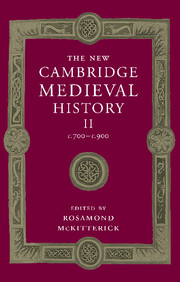Book contents
- Frontmatter
- PART I POLITICAL DEVELOPMENT
- PART II GOVERNMENT AND INSTITUTIONS
- PART III CHURCH AND SOCIETY
- PART IV CULTURE AND INTELLECTUAL DEVELOPMENTS
- 25 Eighth-century foundations
- 26 Language and Communication in Carolingian Europe
- 27 The Carolingian renaissance: education and literary culture
- 28 Theology and the organisation of thought
- 29 Book production in the Carolingian empire and the spread of Caroline minuscule
- 30 Art and architecture
- Conclusion
- Appendix genealogical tables
- List of primary sources
- Bibliography of secondary works arranged by chapter
- Index of manuscripts
- General index
- Frontispiece">
- Plate section
- Map 4 Charlemagne’s Europe and Byzantium, 814
- Map 19 The ecclesiastical provinces of western Europe 700-900
- Map 20 Carolingian schools, scriptoria and literary centres
- Genealogical table X: Wessex
- References
26 - Language and Communication in Carolingian Europe
from PART IV - CULTURE AND INTELLECTUAL DEVELOPMENTS
Published online by Cambridge University Press: 28 March 2008
- Frontmatter
- PART I POLITICAL DEVELOPMENT
- PART II GOVERNMENT AND INSTITUTIONS
- PART III CHURCH AND SOCIETY
- PART IV CULTURE AND INTELLECTUAL DEVELOPMENTS
- 25 Eighth-century foundations
- 26 Language and Communication in Carolingian Europe
- 27 The Carolingian renaissance: education and literary culture
- 28 Theology and the organisation of thought
- 29 Book production in the Carolingian empire and the spread of Caroline minuscule
- 30 Art and architecture
- Conclusion
- Appendix genealogical tables
- List of primary sources
- Bibliography of secondary works arranged by chapter
- Index of manuscripts
- General index
- Frontispiece">
- Plate section
- Map 4 Charlemagne’s Europe and Byzantium, 814
- Map 19 The ecclesiastical provinces of western Europe 700-900
- Map 20 Carolingian schools, scriptoria and literary centres
- Genealogical table X: Wessex
- References
Summary
linguistic frontiers
the period from the eighth to the tenth centuries is highly original from the cultural, literary and linguistic points of view. Thanks to the high reputation of the Carolingian Renaissance, it has been the subject of much research, but whatever the discipline – linguistics, culture, history, literature – many questions remain unanswered. To summarise in a few words the complex problems posed to and by current research, we need to ask the following questions. Which language(s) corresponded to which culture(s) and to which audience(s) did each language communicate?
Three crucial and significant thresholds were successively established during the period from, say, the reign of Dagobert to that of Charles the Bald. Over time, in the Latin-speaking regions, the popular spoken language underwent a metamorphosis by the end of which imperial Latin had given way to early Romance dialects. In the western world, four distinct main groups emerged, some old, some new: the Latin areas (Italy, Gaul, Spain, etc.), the Germanic areas (Old High German, Old English, etc.), the Greek areas (southern Italy, the Peloponnese, Palestine, etc.), and the Arabic areas (Arabia, Syria, Egypt, Spain, etc.). Lastly, within the variable fabric of society, a number of ‘splits’ separated the learned culture of speakers endowed with autonomous access to the written tradition from the popular culture of speakers possessing only collective oral knowledge. How are we to establish a clear chronology for these cumulative ‘broken lines’?
Keywords
- Type
- Chapter
- Information
- The New Cambridge Medieval History , pp. 695 - 708Publisher: Cambridge University PressPrint publication year: 1995
References
- 7
- Cited by

